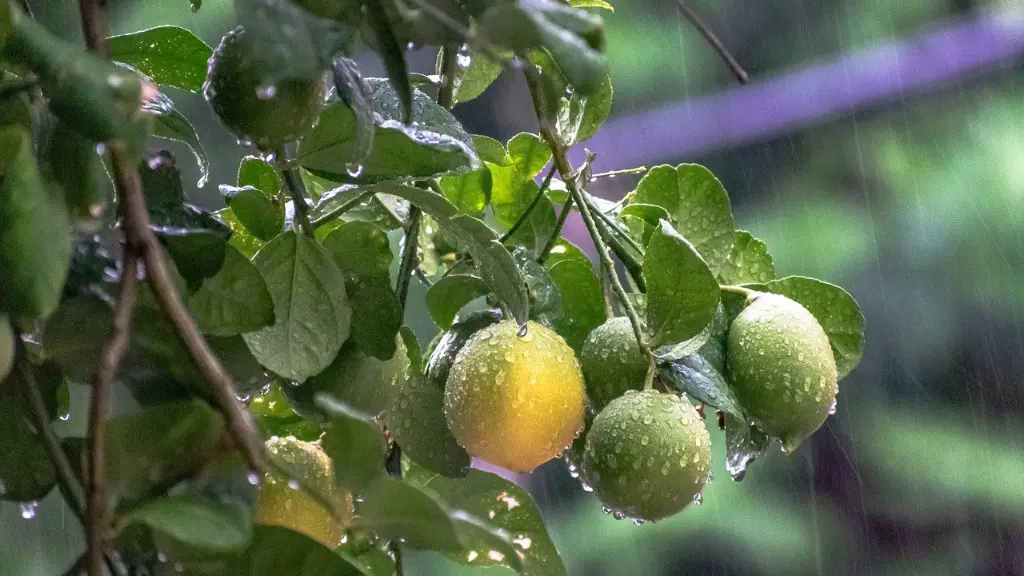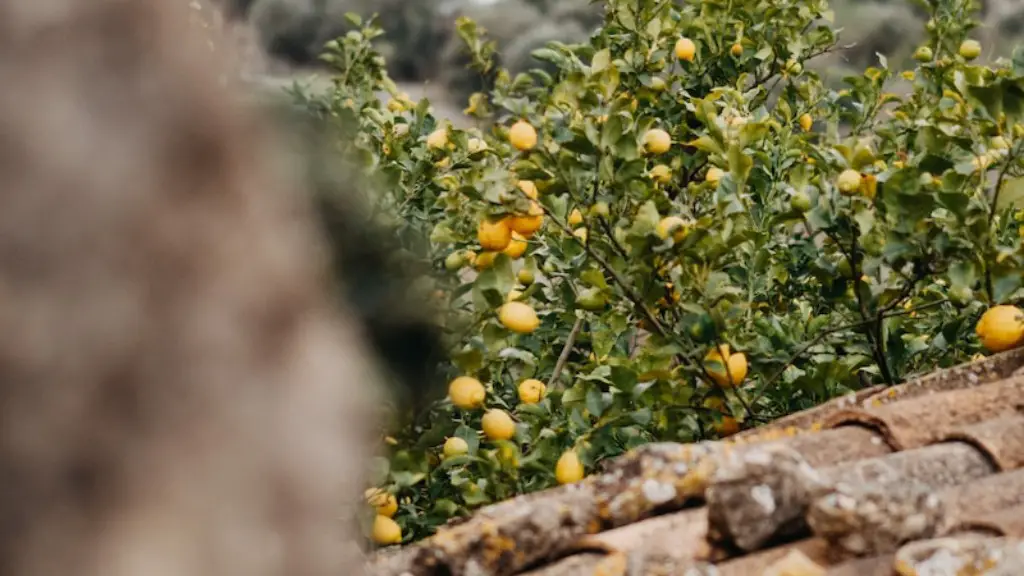Getting a dwarf lemon tree is a great way to add a touch of greenery to your home or garden. It can flourish indoors or outside and offers a unique, miniature version of a classic tree. Here’s how to get a dwarf lemon tree of your own and make sure it’s well-maintained and healthy.
First, you’ll need to find a sunny spot for the tree, ideally with at least six hours of sunlight per day: south or southwest facing are good choices. You should also make sure that the surface where the lemon tree will be placed is well-draining: if planting in a pot, make sure the pot has suitable drainage holes.
When you have found the right spot and have the pot ready, it’s time to plant the tree. Put some potting soil in the pot, extending up near the top. Put the tree in the pot and ammend the potting soil around the trunk and the roots. Make sure the tree is firmly planted and that the roots are beneath the surface, then water thoroughly so that the soil is moist but not waterlogged.
To ensure your tree’s continued health, regular pruning is essential. Pruning helps to balance the tree’s structure, encourages healthy leaf growth, aids sun exposure and air circulation and helps keep the size manageable. Depending on the size and shape of your tree, you can use bypass hand pruners, bypass long reach pruners or anvil long reach pruners. Get into the habit of checking the tree for any dead or unhealthy branches, and cut away from the main stem.
Fertilizing your tree can also help it to grow correctly. You should use a fertilizer specially formulated for citrus trees, intended for both young and mature trees, and feed the tree twice a year. Generally, a slow-release fertilizer is best.
Finally, giving the tree regular watering is essential. Newly planted trees should be regularly watered until they become established, usually over the course of a few weeks. After that, water whenever the top of the soil is dry. Remember, while these trees require some water to survive, they don’t need a lot. Too much moisture can actually be harmful.
Soil Requirements
When it comes to soil, dwarf lemon trees require a well-balanced soil with a pH between 6 and 8. A potting soil mix for citrus trees is ideal, or you can use a mixture of two parts potting soil and one part coarse sand. It is worth investing in high-quality soil, as this will affect how well your tree grows and how healthy it is.
Because these trees will usually be planted in containers, they require well-draining soil; that is, soil with low water-holding capacity. To be sure, a good test is to fill a container with your soil blend and add water; if the water pools on the surface and isn’t absorbed, you may need some more sand.
You can test the pH of your soil before planting, or after, by using a soil test meter. Be aware that pH tests are affected by water, so be sure to use the same water in the mixture to obtain a consistent result.
When the tree is in its pot, cover the soil with mulch or gravel to help trees to retain moisture and remain healthy.
Planting
When prepping the dwarf lemon tree for planting, you should remove any broken, dead or diseased roots, then trim any live roots that may be too long. Soak the roots in lukewarm water for a few hours, then wrap them in a damp cloth until planting.
Leading up to planting time, using a slow-release fertilizer on the soil can be beneficial. If the pot that you’re going to use doesn’t have drainage holes, you can create them yourself using a drill, and be sure that the pot isn’t too large as this could encourage root rot.
When you are ready to plant, add the soil, putting it in the container so that it is slightly below the rim. Place the tree in the pot and be sure that it is the right depth, with the crown of the tree at the same level as it was in the original pot. Firmly pack the soil around the roots, then water to make sure the tree is securely in place.
When you are finished, you may wish to add gravel or mulch on top of the soil, this will help the tree to retain moisture.
Light Requirements
When positioning a dwarf lemon tree in your home, you should find a sunny spot, preferably with at least 6 hours of sunlight per day. Of course, the more sun and light that the tree gets, the better: if the tree doesn’t receive the necessary exposure, it won’t develop or produce healthy fruit or flowers. You should also take into account the amount of exposure when choosing a spot; indoor trees may need more protection from the sun than those planted outdoors and vice versa.
Alternatively, if you don’t have an appropriate spot indoors, you could invest in an artificial light source. Artificial lighting can help if natural light is lacking, however, if you choose to go down this route, it’s best to do some research first, as the type of light and exposure needed depends on the specific tree.
In addition, using some sunshade during the hottest hours of the day can be beneficial. The best way to do this is to place a light curtain in front of the tree. This way, exposure to direct sunlight can be limited if needed and your tree can still receive plenty of light.
Pruning and Maintenance
Overall, dwarf lemon trees require regular care and maintenance to remain healthy. Pruning is essential, as this helps to manage the size of the tree, balance its structure and encourage healthy leaf growth. When pruning away dead or unhealthy branches, be sure to use the right tools for the job.
Fertilizing is another essential part of maintaining a healthy dwarf lemon tree. It is important to use a fertilizer suitable for citrus trees; slow-release fertilizers are ideal as these help to prevent any nutrient overload. Generally, a citrus tree should be fertilized twice a year: once in the spring and then again in the summer after flowering.
Finally, regular watering is key to ensure your tree’s health. Newly planted trees should be watered consistently, but not too much. Once established, check the soil to determine when the tree needs water and ensure that it is never waterlogged; a good trick is to use a wooden stick to check the moisture level.
Pest and Disease Prevention
In order to keep your lemon tree healthy, prevention is key. Monitoring is important, as pests can be difficult to identify and may take some time to spot. Once a pest is noticed, action should be taken quickly to help deal with the problem and keep the tree healthy.
There are various pests and diseases that a lemon tree may be vulnerable to, but some of the most common are aphids and scale insects. Aphids can be identified by yellow spots on the leaves, while scale insects can appear as brown or black lumps along the stem and branches.
If detected, these pests can be treated with an insecticidal soap or an organic oil pesticide. Be sure to read the instructions carefully and take into account the size of your tree.
In addition, yellow leaves may indicate nutrient deficiency, or it could be a sign of over-watering. It is best to audit your tree’s environment to determine the cause.
Harvesting and Propagation
When it comes to harvesting, dwarf lemon trees can take up to two years to start producing fruit. In the meantime, you can use a ripe fruit from the grocery store and place it in the tree. This can help to encourage fruiting faster.
When the tree starts producing fruit, you can begin harvesting right away. With dwarf lemon trees, the more you harvest, the more the tree will produce, so it is best to keep up with the fruits. Use a pair of sharp pruners to remove the fruit and make sure to leave some stems, as these will produce more fruit.
Finally, if you’re looking to increase your lemon tree’s productivity, you can try propagation. There are several methods for propagation, all of which can be done at home, including air layering, budding, grafting and taking cuttings. Beginners should start with air layering, as this method is relatively easy, and is proven to be successful.




